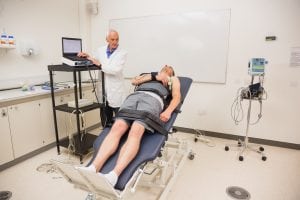
Tilt Table Test
The tilt table test is predominately used to determine the cause of syncope or fainting, although it is also used when heart block is suspected.
Prior to the test, electrodes will be attached to your chest and a blood pressure cuff is placed around an upper arm. You then take your place on a table which pivots, placing your feet in the supports while safety straps are placed around your body.
The test begins with you lying horizontally on the table. After 5-15 minutes the table is suddenly raised into a vertical position - normally between a 60-90 degree angle - which reflects a change in position from lying down to standing up. The table will then be kept in the upright position for up to 45 minutes, during which time your heart rate and blood pressure are monitored. While in the upright position you must remain as still as possible.
During the vertical element of the test, you should alert a member of the medical team if you feel symptoms such as nausea, sweating, feeling faint or irregular heartbeats.
If you faint during the test, the table is immediately returned to the horizontal position and you're condition is closely monitored. Most patients regain consciousness almost immediately. In some cases, if blood pressure and heart rate changes indicate you are about to faint, the table is returned to a horizontal position and you may not lose consciousness.
Once the test is completed, most patients can return to their normal activities without any issues.

We believe the best cardiac care can only be achieved by the best cardiologists in their fields, working together, for you and your heart. Our consultants are able to offer appointments throughout the week and at weekends.